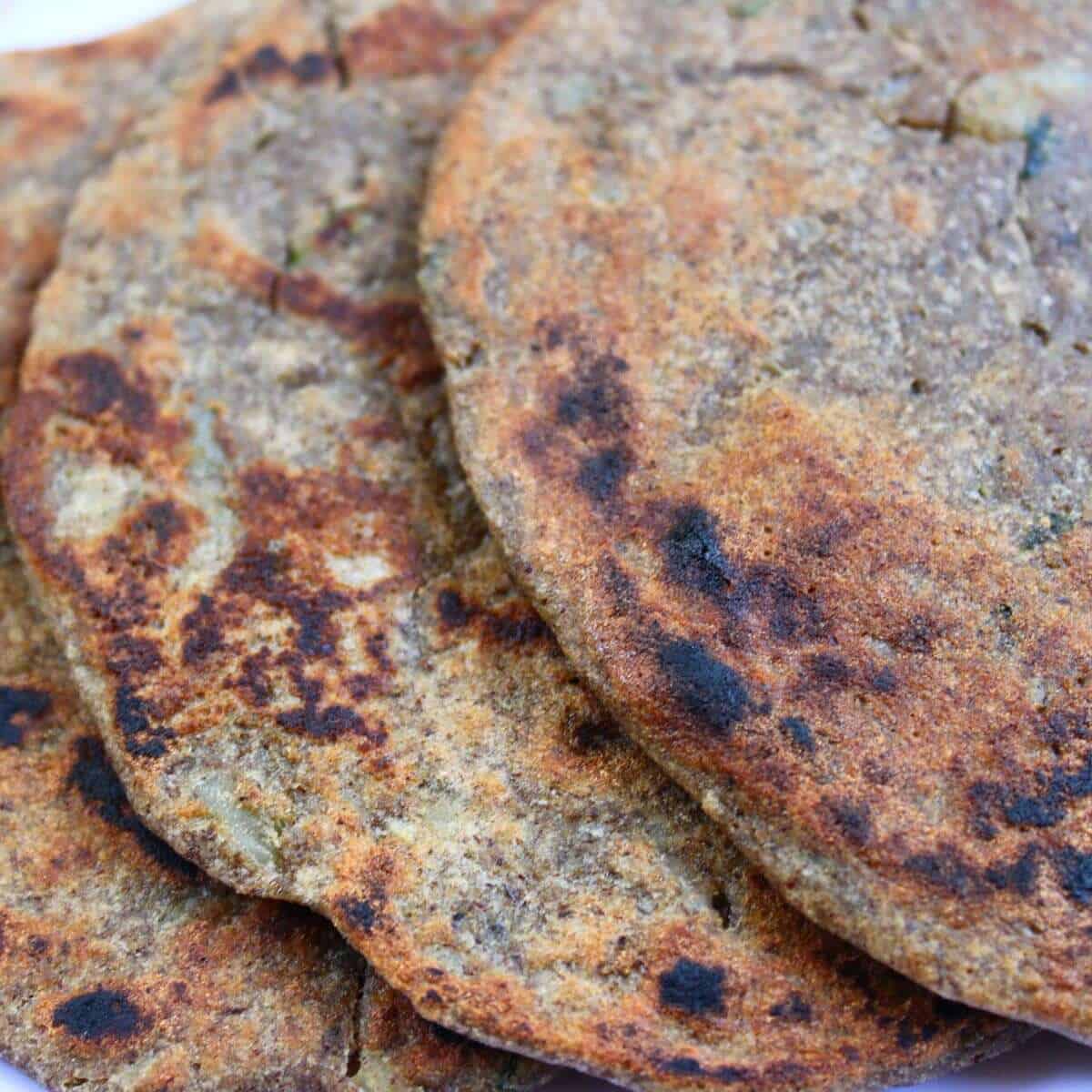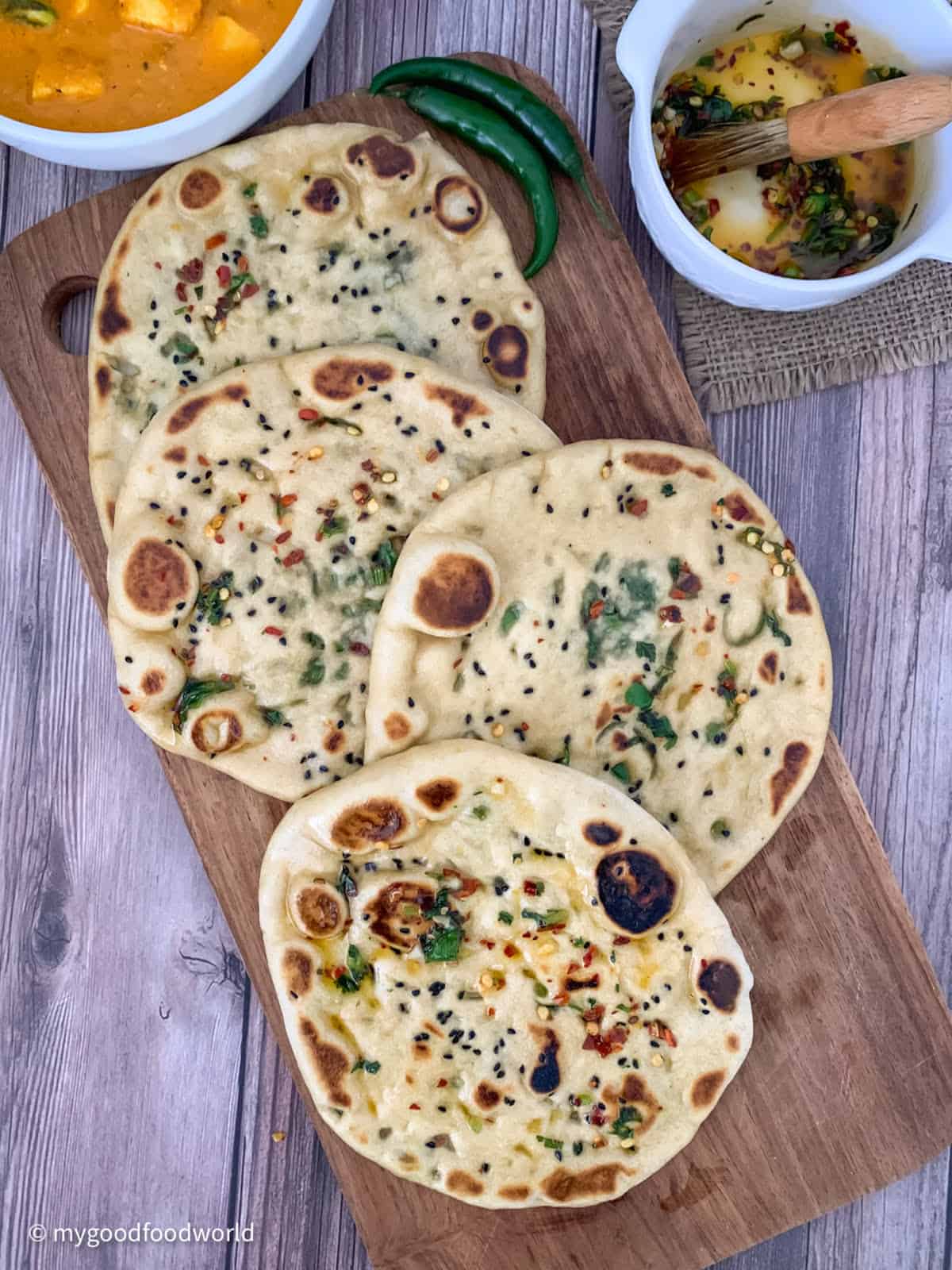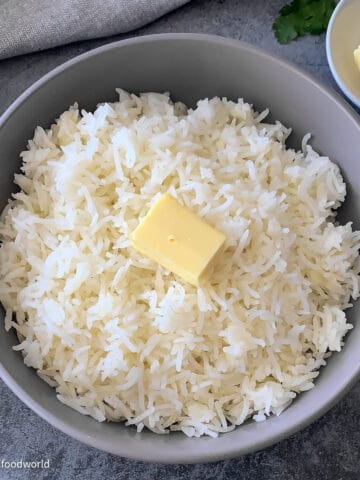In the vast universe of Indian bread, roti, and naan hold the crown. They are an integral part of a meal in almost every South Asian household. Although sometimes used interchangeably, these flatbreads are different from one another. Continue reading this blog post about roti vs naan to understand the differences and discover your favorite.

Save This Recipe
Enter your email & I'll send it to your inbox.
By submitting this form, you consent to receive emails from MyGoodFoodWorld
In India, the term roti is used generally to refer to all types of flatbreads. At first glance, the process seems the same: wheat flour is mixed with water, kneaded into a dough, and then baked over a fire. However, when you delve deeper, you will find a lot of differences - from the ingredients in the dough to the kneading and rolling techniques, and even the cooking methods.
In a typical Indian lifestyle, lunch is the heaviest meal. A typical vegetarian meal, known as a "thali" includes vegetables, lentils, dairy products, rice and roti. Side dishes, chutney and pickles are integral part of the meal.

A variety of flatbreads such as roti, phulka, naan, paratha, poori, bhakri, parotta, and chapati are staples in an Indian household. In this article I will also briefly explain these different types of commonly made flatbreads and some of their regional variations.
Read on to know more about the roti vs naan debate.
Jump to:
What is roti?
Roti is a type of flatbread that originated in India and has now become a staple food in several South Asian countries such as Pakistan, Bangladesh, Nepal, and Sri Lanka. It is also known as chapati. Roti is a round and unleavened flatbread made using whole wheat flour, also known as atta.

The term chapati originates from the Hindi language, meaning "to slap". Traditionally, the dough is slapped between the hands to make a rough flatbread.
To make rotis, wheat flour is mixed with water to form a soft dough. Some people add salt to the flour while others don't - it's typically a matter of personal preference. The dough is divided into balls and rolled thin with a rolling pin. The rolled-out roti is then baked on a hot, usually cast iron, flat skillet, or griddle pan known as tawa.

As a variation, just as I have done with this turmeric roti, the flavor and texture of a basic roti can be enhanced by adding spices and herbs.
Types of roti
There are so many different types of roti made with whole wheat flour, and even more when you consider regional variations and different types of flours! Here are some common types of rotis that are enjoyed all over India and indeed, around the world.
I know it can be confusing, but the clue, as you’ll discover, often lies in the name itself.
Tandoori Roti: Simply put, it’s a roti that’s baked in a tandoor, a clay oven. The rotis are slapped onto the walls of this super hot, rustic oven, and bake in the intense heat in under a minute!

Phulka: These are soft, thin rotis that are initially cooked on the tawa and then placed over a flame. They puff up and the steam cooks them from the inside. The word phulka means puffed.

Paratha: This is a type of roti that's a layered flatbread. The name comes from the Hindi word "parat" which means layers.
Parathas can be plain or stuffed. Plain parathas usually have just ghee (or oil) between the layers, which makes them flaky and melt-in-the mouth soft!
Stuffed parathas have a filling made with vegetables such as potatoes, radish, and cauliflower, and pan-fried with oil or ghee. They are usually paired with some pickled mooli and a yogurt-based dip.
In Southern India, there is a version of paratha made with plain white flour known as parotta.
Roomali roti: These super-thin and super-soft rotis, are folded like a handkerchief (roomal). They are made with a combination of whole wheat flour and all-purpose flour. They are popular in Mughlai cuisine and pair well with a hearty side dish like this kala chana.

Poori: These small, deep-fried breads are commonly paired with potato side dish and make a delicious breakfast.
In Eastern India, there is a variation of poori that is known as luchi. Luchis are made with plain, all-purpose flour, just like parottas.
Missi roti is a type of savory, flavorful roti made with a blend of wheat flour and chickpea flour, also known as besan. The flour is mixed with spices and fresh herbs to enhance the taste. It is usually served with plain yogurt and pickles, making it a simple yet delicious meal.
Variations of rotis
In many parts of India, rotis are not made solely with wheat flour. Flatbreads made with rice, millets, and pseudo-cereals are a common staple in meals, especially in rural areas. These rotis are called bhakhris. Jowar bhakri, made with sorghum, and bajra roti, made with pearl millet, are two of the most popular millet rotis that are commonly made and enjoyed in Western India.
In South India, akki roti and ragi roti are popular alternatives to wheat rotis. Akki roti is made with rice flour, while ragi roti is made with finger millet.
Rotis made with buckwheat, or kuttu in Hindi, is an essential part of many Indian meals, particularly during special occasions, festivals and fasting periods.

Enjoying the roti vs naan discussion so far? If you have any questions, comments, or thoughts, please share with me via the comment section below. I would love to hear from you. - Padma
What is naan?
In this roti vs naan comparison, we have understood that roti is an unleavened flatbread made with whole wheat flour.
Naan, on the other hand, is a leavened flatbread and is made with plain white flour, also known as maida.

The leavening agent used to make naan bread fluffy is yeast. Those who prefer yeast-free naan bread use baking powder and soda. Naan, like tandoori rotis, are roasted in a tandoor oven.
To prepare naan bread, a mixture of plain flour, yeast, salt, sugar, and water is kneaded into a dough. The naan dough is then allowed to rest and rise. Next, the dough is divided into balls and rolled out thick using either a rolling pin or by hand. For extra flavor, the rolled-out naan is sprinkled with nigella seeds and finally baked in a hot clay charcoal oven. Nowadays, it is also common to bake naans in a regular oven or on a cast iron pan.
People who prefer their naans to have a chewy texture may add yogurt, milk, or eggs to the flour.
Naans' bread-like pillowy texture makes it the perfect scoop for a curry or a dal, such as this spinach dal.
Types of naans
Naan has a rich history and was introduced to India by the Mughals. Since then, this delicious leavened bread has found its place in Indian homes.
Over the centuries, different kinds of naan have been made, some with simple ingredients and others using exotic ones. Here are some of the popular types of naan that are enjoyed in India and around the world.
Garlic naan: This is a popular Indian dish consisting of plain naan stuffed with garlic or brushed with butter and fresh coriander (cilantro) leaves. It is also known as garlic-coriander naan.
Other variations of this type of naan can feature mint instead of cilantro and chopped chili peppers instead of garlic.
Butter naan is naan that is generously brushed with butter.

Cheese naan: This is a modern adaptation where the naan is stuffed with melty cheese.
Peshawari naan: This is a popular sweet breakfast naan stuffed with sultanas, nuts, dried fruits and dessicated coconut, typically enjoyed with a hot cup of chai.
Keema naan is a type of naan that is usually stuffed with lamb or goat mince and brushed with a generous amount of butter on top. The word "keema" means "mince," and because of its spicy filling, this naan can be enjoyed on its own as a snack or paired with a side dish in a meal.
Kulcha: Simply put, kulcha is a type of stuffed naan that can be filled with vegetables, paneer, or mincemeat. Kulchas are characterized by their soft, chewy, and flaky texture. If you want to try making stuffed kulcha at home, check out my easy stovetop onion kulcha recipe.
Difference between naan and roti
Now that we have a good understanding about rotis and naans, here is a summary of roti vs naan:

So the key differences are:
- Roti is an unleavened bread, while naan is leavened with yeast, baking powder, or baking soda.
- Naan is typically made with plain flour, whereas roti is usually made with whole wheat flour.
- Roti is typically made using only flour, water, and salt, while naan includes yeast, salt, sugar, and water. Additional ingredients like yogurt, eggs, and milk can be added to make the dough chewier.
- Roti is a type of bread that has its origins in India. On the other hand, naan is also a type of bread that was introduced to India by the Mughals.
- Most rotis are thin and soft, while naan is thick, soft, and chewy.
Which is better roti or naan?
Ah, that's quite a tricky question! My answer would be that I choose both options!
To answer your question, my choice of bread would depend on what I'm pairing it with. For instance, if I'm having a curry with a scoopable consistency like shahi paneer, I would prefer to have it with naan. This is because naan is thick enough to not get mushy with the sauce.
On the other hand, if it is a dry dish like Punjabi aloo gobi or caramelized mushrooms on the menu, I would prefer to have rotis.
Rotis are considered healthier than naans from a nutritional standpoint because they are made with whole wheat flour, providing more dietary fiber and other essential nutrients. Additionally, from a dietary restriction perspective, rotis are a better option as they are dairy-free.
Frequently Asked Questions
Naan and khamiri roti are two popular types of Indian bread that differ in their ingredients. Naan is made with refined flour, while khamiri roti is made with whole wheat flour.
The term "khamir" means yeast, and traditionally, the whole wheat dough was left to ferment overnight with wild yeast. This fermentation process gives khamiri roti a slight tanginess, softer texture, and its own unique flavors which is why it is a favorite among many.
Both naan and roti are integral to Indian cuisine. Roti originated in India, so it is more widely consumed across the country, while naan is mostly consumed in the Northern regions.
Roti and naan are two types of popular Indian flatbreads. Roti is made using whole wheat flour, water, and salt, while naan is made using all-purpose flour, yeast, salt, sugar, and water. Roti is soft, circular, and thin, whereas naan is thick, fluffy, chewy, and often tear-shaped. Roti originated in India, while naan was brought to India by the Mughals.
Roti and naan are made with different types of flour. Roti is made with whole wheat flour while naan is made with refined wheat flour. As a result, roti is more nutritious and healthier than naan as it has more dietary fiber and other essential nutrients.
If you have enjoyed this roti vs naan debate, please take a moment to leave a comment and a rating below. This will motivate me to create more good content for you! You can also engage with me on Twitter, Facebook, and Instagram. - Padma




Tracy McHugh says
Thanks for the description! I've never had roti before but I LOVE naan with chutney.
Padma Kumar says
Thank you so much for reading Tracy.
Bonnibelle says
Such an informative post! I share your general sentiment of loving bread and gladly enjoy both lol.
Padma Kumar says
Yes :-))
Laurie Griggs says
Thanks for the explanation. I love learning about Indian foods and the traditions and culture behind it!
Padma Kumar says
Thank you so much Laurie. So glad you found it useful.
Shannon says
Wow, that was a lot of information and so very interesting and informative. I can't wait to make and try both types of bread. I usually buy naan bread, but I had no idea how easy it could be, and to add new flavors. Thank you so much for the information!
Padma Kumar says
Thank you Shannon, I am so glad that you find this useful.
vicky says
Ah, I never understood the difference, but now I do. Thank you for a very informative post! All the yummy images makes me hungry too!
Padma Kumar says
Thank you Vicky. So glad that you find it informative.
Diane says
This is so helpful! I hadn't realized there were s many varieties.
Padma Kumar says
Thank you Diane.